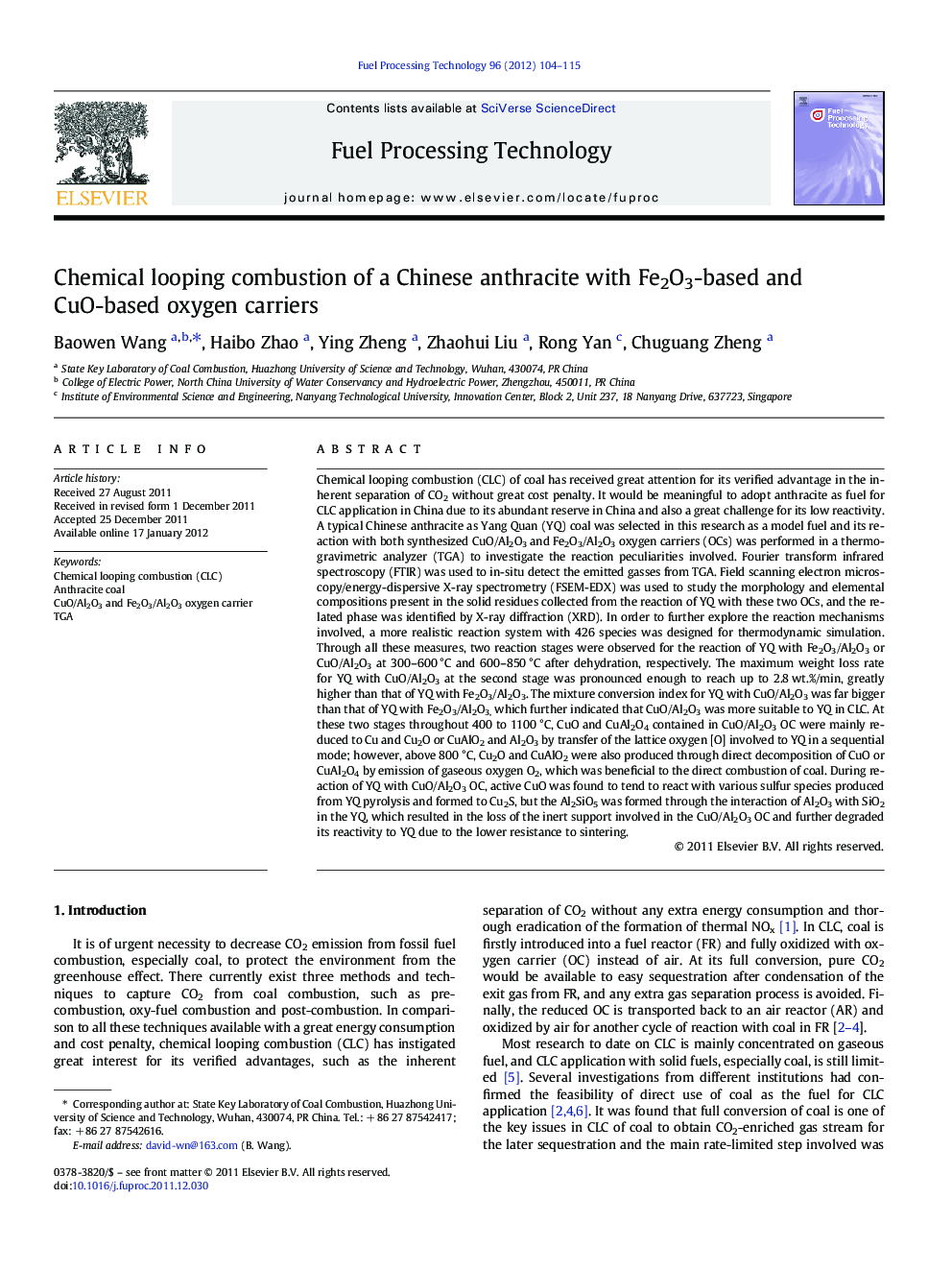| کد مقاله | کد نشریه | سال انتشار | مقاله انگلیسی | نسخه تمام متن |
|---|---|---|---|---|
| 210394 | 461709 | 2012 | 12 صفحه PDF | دانلود رایگان |

Chemical looping combustion (CLC) of coal has received great attention for its verified advantage in the inherent separation of CO2 without great cost penalty. It would be meaningful to adopt anthracite as fuel for CLC application in China due to its abundant reserve in China and also a great challenge for its low reactivity. A typical Chinese anthracite as Yang Quan (YQ) coal was selected in this research as a model fuel and its reaction with both synthesized CuO/Al2O3 and Fe2O3/Al2O3 oxygen carriers (OCs) was performed in a thermogravimetric analyzer (TGA) to investigate the reaction peculiarities involved. Fourier transform infrared spectroscopy (FTIR) was used to in-situ detect the emitted gasses from TGA. Field scanning electron microscopy/energy-dispersive X-ray spectrometry (FSEM-EDX) was used to study the morphology and elemental compositions present in the solid residues collected from the reaction of YQ with these two OCs, and the related phase was identified by X-ray diffraction (XRD). In order to further explore the reaction mechanisms involved, a more realistic reaction system with 426 species was designed for thermodynamic simulation. Through all these measures, two reaction stages were observed for the reaction of YQ with Fe2O3/Al2O3 or CuO/Al2O3 at 300–600 °C and 600–850 °C after dehydration, respectively. The maximum weight loss rate for YQ with CuO/Al2O3 at the second stage was pronounced enough to reach up to 2.8 wt.%/min, greatly higher than that of YQ with Fe2O3/Al2O3. The mixture conversion index for YQ with CuO/Al2O3 was far bigger than that of YQ with Fe2O3/Al2O3, which further indicated that CuO/Al2O3 was more suitable to YQ in CLC. At these two stages throughout 400 to 1100 °C, CuO and CuAl2O4 contained in CuO/Al2O3 OC were mainly reduced to Cu and Cu2O or CuAlO2 and Al2O3 by transfer of the lattice oxygen [O] involved to YQ in a sequential mode; however, above 800 °C, Cu2O and CuAlO2 were also produced through direct decomposition of CuO or CuAl2O4 by emission of gaseous oxygen O2, which was beneficial to the direct combustion of coal. During reaction of YQ with CuO/Al2O3 OC, active CuO was found to tend to react with various sulfur species produced from YQ pyrolysis and formed to Cu2S, but the Al2SiO5 was formed through the interaction of Al2O3 with SiO2 in the YQ, which resulted in the loss of the inert support involved in the CuO/Al2O3 OC and further degraded its reactivity to YQ due to the lower resistance to sintering.
► OCs were prepared using the novel sol-gel combustion synthesis method.
► Reaction of the synthesized OCs with Chinese anthracite was performed.
► Effect of support Al2O3 on the reaction of the anthracite with OCs was studied.
► The reaction mechanisms involved were explored.
Journal: Fuel Processing Technology - Volume 96, April 2012, Pages 104–115